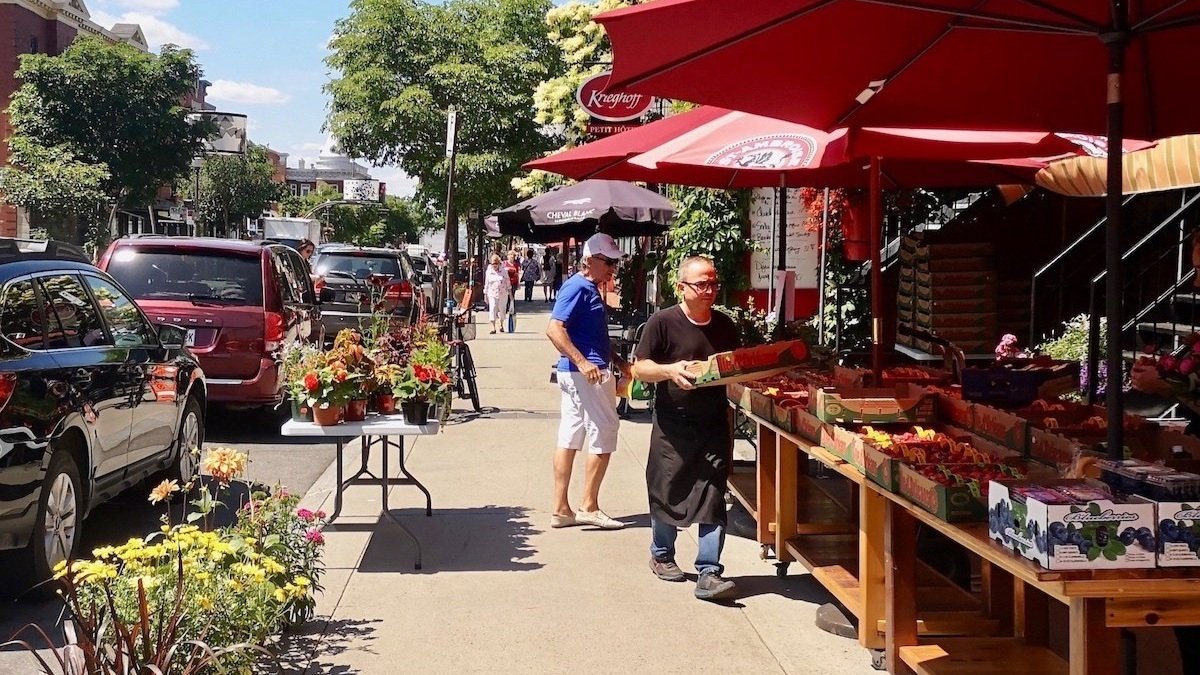Planning Without Plans
This is part one of a two-part essay by Strong Towns member Tristan Cleveland. You can read part one here.
Quebec City main street. (Source: Author.)
A growing number of communities want to become walkable: the kinds of places where it is possible to stroll to local shops and transit. Walkability is crucial for improving health, fighting climate change, and supporting social connections.
Unfortunately, it takes an enormous amount of resources to re-write a community’s plan to support walkability—and many communities lack those resources. The process usually involves multiple rounds of consultation. The plans themselves are long, detailed documents, giving an account of local history and touching all aspects of life. The regulations are complex and difficult to write, especially for planners who have spent their careers working on single-family zoning.
Big cities like New York and Vancouver can afford such an expensive planning process, but other communities are left behind. Meanwhile, the climate continues to warm and rates of diabetes continue to grow, in part because it takes too much work just to update zoning.
In the first part of this essay, I argued that planning takes more work than planners can do. This can’t continue. We need an approach to building strong, healthy communities that all communities can implement, no matter their size and budget.
(Source: Wikimedia Commons.)
Focus on Fundamentals
Walkability has widely-known requirements: density, mixed uses, small blocks, safe streets, greenery, and pedestrian-friendly architecture. Most planners can easily recognize this list.
It is therefore a bit odd that if a community wants to become walkable, it needs to go through a multi-year planning process to re-identify these requirements. It is strange as well that planners must rigorously consult the public on their unique local vision and goals, and then write chapter after chapter on how to address every social ill, just to implement the things that all walkable communities need.
I propose a different approach. If a community decides to become walkable, its zoning should be replaced immediately with a set of generic state or national regulations. These rules should cover the core requirements of walkability, so that the community can focus instead on writing a smaller set of rules that address issues that are in fact local to their community (as I describe further below). Communities do not need to reinvent the building code every time they write a plan. Neither should they have to reinvent rules for walkability.
Many planners will find this outrageous. After all, one size does not fit all. The goal, however, is not to make every community identical, but to write a simple set of rules that enables wide diversity.
Charles Marohn proposes, for example, that cities should not set specific height limits for each street. Instead, rules should allow everyone throughout a community to build a little higher than the current average height on the street, based on a generic formula. That way, each street would be allowed to slowly densify over time, without anyone needing to continuously update height limits. This simple rule would enable a greater diversity of density than any zoning map—and would require much less work.
Rules should also allow residents to open a business in their homes if they are adjacent to existing businesses or are on the short end of a block. Rules should disallow any land use that causes excessive noise, smoke, and odors (as in Tunis). Otherwise, planners should let residents decide which kinds of businesses they want to open where. Customers will let them know whether the business is needed.
Architectural design rules should ensure that no building undermines the desirability of walking on a street. Rules should strictly forbid blank walls. Excessive setbacks should be out. Large parking lots next to sidewalks should be out. Rules should prohibit specific problems, and allow everything else.
Such rules require judgement, which is why Tunis relied on judges. Planners would need training to apply such rules in a way that is both reliable and sensitive to local context. I submit, however, that planners can better accommodate community diversity by interpreting a few simple rules flexibly than by writing a private legal code for each neighborhood.
Local Rules Focused on Local Issues
Once this baselayer of walkability rules is in place, a community may then wish to write a layer of more specific local rules. Perhaps, for example, residents want all homes to have a certain kind of windowsill to reflect historical context.
Halifax residential street. (Source: Author.)
Such local rules are important, but they should focus on what is in fact specific to a place. Local rules should not rehash the generic requirements of walkability, and they must not violate these requirements—just as local plans cannot violate the building code.
If rules do focus narrowly on idiosyncratic local preferences, they will be much easier to manage. One could add and delete rules individually without worrying that a single change will undermine how homes, shops, and streets interact, since these basics are already covered by walkability regulations. This would free planners to make changes as needed without an all-encompassing plan review.
If a community wants to create guidelines for local porches, this should not require the regalia of a 10-year community plan, hundreds of hours of consultation, and long lists of goals and actions. A public meeting should suffice.
Plan to Fix Problems, Not to Manage Growth
In everyday life, people usually say “I need a plan” if something has gone wrong. Plans should play a similar role in cities. If a community is today defined by large gray parking lots, and it wants to become walkable, it may need a plan to get from here to there.
However, if a community already has small blocks, local shops, safe sidewalks, and street life, it doesn’t need a plan. At this stage, enabling growth should be a matter of standard operating procedure.
Planners should of course make ongoing investments in streets, parks, bike lanes, and transit, but none of this requires plans, either—unless the system is currently broken in some way. Instead, according to the Strong Towns approach, planners should identify specific pain points and make small, incremental improvements in collaboration with residents. This methodology focuses on fixing visible problems, not on envisioning a distant future.
Farmers don’t need a plan to take care of apple trees. They need a schedule, routines, and methodology. Planners should support walkable growth with a similar level of professionalism and regularity. They should treat plans as a tool for fixing aberrant conditions, not for managing normal life.
If we really want to support diversity, we should establish a simple set of general rules that enable communities to grow by their own logic. In most places, we should stop planning. Instead, we should support the basic needs of growth, and help communities develop organically.
This focus on fundamentals will enable far greater complexity than planners can dictate in official policy. Even better, it will require much less work. Planning could become a job planners can actually accomplish within their limited time and budget.
And that’s essential, because if planning is a bigger job than planners can do, the public’s health suffers and greenhouse gas emissions will continue to rise. It is our responsibility as planners to design a process that is sufficiently cost-effective to implement in cities large and small. We simply cannot afford to spend years designing a massive 10-year comprehensive plan for each and every community.
Strong Towns members are changing the conversation about growth and development across North America. Join the movement. Become a member today.
Tristan Cleveland is an urban planner with Happy City. He is also a PhD candidate at Dalhousie University's Healthy Populations Institute, studying how to ensure communities are designed to support human health.
You can connect with Tristan on Twitter at @LUrbaniste.







Advocates must adjust the way they talk about city planning. Overuse of jargon and a strict focus on logical debate alienates people, but focusing on the concrete benefits of better urban design — or, even better, showing those benefits — can make change more appealing.